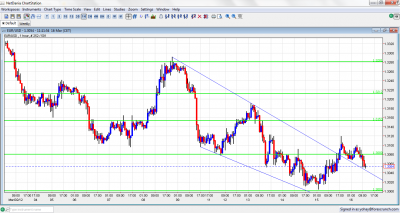Euro dollar managed to escape downtrend resistance and move higher, but it failed to gain momentum and is falling once again. After the IMF approved its share in the second Greek bailout, the debt crisis issues have certainly calmed down, but this was already priced in. More positive figures from the US support the dollar. To close the week, we have consumer confidence and inflation numbers. Inflation, especially related to oil prices, is certainly on the agenda as the situation in Iran heats up.
Here’s an update on technicals, fundamentals and what’s going on in the markets.
EUR/USD Technicals
- Further levels in both directions: Below: 1.30, 1.2945, 1.2873, 1.2760, 1.2660 and 1.2620.
- Above: 1.3080, 1.3150, 1.3212, 1.3280, 1.333, 1.3430, 1.3486, 1.3550 and 1.3615.
- Downtrend resistance was broken, but the pair might slip back in there.
- Note that 1.30 is a psychologically important number, but doesn’t offer much support.
- 1.3280 proved to be strong on the upside once again.
Euro/Dollar sliding back towards channel – click on the graph to enlarge.
EUR/USD Fundamentals
- 10:00 Euro-zone Trade Balance. Exp. +6.2 billion. Actual 5.9 billion.
- 12:30 US CPI. Exp. +0.4%. Core CPI exp. +0.2%.
- 13:15 US Industrial Production. Exp. +0.4%.
- 13:15 US Capacity Utilization Rate. Exp. 78.9%.
- 13:55 US UoM Consumer Sentiment. See how to trade this event with EUR/USD.
For more events later in the week, see the Euro to dollar forecast
EUR/USD Sentiment – Details of hurdles
- Dollar Storm Wanes: The FOMC left policy unchanged, as expected. This strengthened the US dollar significantly and triggered a dollar storm. The statement included an acknowledgement of higher oil prices and a more upbeat wording regarding employment, such as “the unemployment rate has declined notably”. After the initial storm, the markets certainly calmed down towards the weekend.
- IMF Releases Greek Money: The IMF joined the Eurogroup and gave the final approval to the second Greek bailout, worth 130 billion in total. This happened after Greece completed the PSI successfully and the new estimation is that Greece will now reach a debt-to-GDP ratio of 117% in 2020. A fresh troika reports see Greece missing 2013 targets already, with more austerity needed after the elections. The IMF will release an initial sum on Monday.
- Iran conflict heating up: In an unprecedented move, SWIFT announced it will cut off Iranian financial institutions from Saturday. This joins heightened rhetoric in Israel and elsewhere, and keeps oil high. See 5 signs that a war with Iran is getting closer.
- Rising US bond yields: Yields on short term and long term US yields are on the rise, and this pushes funds into dollars. The effect is stronger in USD/JPY, but EUR/USD can’t ignore it. Since Bernanke’s move, stock markets and the dollar move together. This is a big change. Good US news helps the dollar, and bad news weakens it. This may sound very normal, but it hasn’t always been this way. See the video explanation here.
- Rating agencies keep Greece low: While Fitch raised Greece’s rating to B-, other agencies kept it lower. Also Fitch’s high rating is very low, and reflects a good chance of another default. The markets agree. Yields on Greece’s new, swapped, 10 year bonds point to trouble – 19%. Note that Greece is already off track – the program assumed a contraction of 6.9% in the Greek economy in 2011, while the actual result was 7.5%. Unemployment is on the rise.
- PSI – deadline open for foreign law bonds: Greece completed the PSI for Greek law bonds. The new ones are already trading at a quarter of a euro on the euro, reflecting a high chance of another default. There is a small portion of bonds under international law. The deadline for the PSI on these bonds is March 23rd. Note that there are specific bonds that include a loophole – one that could still cause a delay.
- Worries from China: The economic giant joined its neighbor Japan and posted a huge trade deficit, is seeing a continued housing slump, and a sharp drop in car sales.
- Draghi warns about inflation: The ECB left rates unchanged and made no policy changes. In the press conference, Draghi was very satisfied with the LTROs. He also warned about inflation, and said that the ECB has tools to fight it. Today’s CPI will provide more insight.

